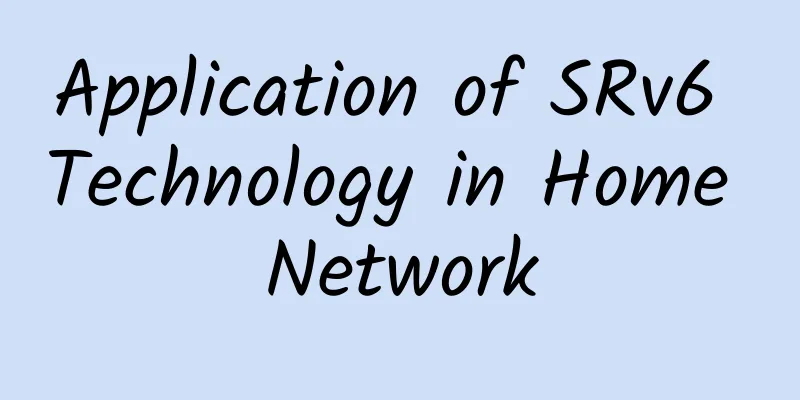Application of SRv6 Technology in Home Network

1. SRv6 ConceptSegment Routing (SR) is a source routing technology that assigns a Segment ID to each node or link. The head node combines these Segment IDs to form a Segment List and directs packets to be forwarded according to the Segment List, thereby realizing the programmability of the network. Currently, Segment Routing technology mainly has two implementations: SR-MPLS and SRv6. Among them, SR-MPLS is a Segment Routing implementation based on the MPLS data plane, and its SID is the MPLS label (Label); SRv6 (Segment Routing over IPv6, segment routing based on IPv6) is a Segment Routing implementation based on the IPv6 data plane, and its SID is the IPv6 address. SRv6 combines the source routing advantages of Segment Routing with all the characteristics of IPv6, and has multiple network programming spaces, which is in line with the SDN (Software Defined Network) concept. 2. SRv6 Implementation Principle2.1 SRH packageSRv6 implements segment routing by inserting a routing extension header SRH (Segment Routing Header) into the IPv6 packet header to carry segment transmission information. SRH contains a Segment List represented by a SID list with IPv6 address characteristics. The destination address of the packet will be updated segment by segment according to the Segment List, thereby completing segment-by-segment forwarding. The SRv6 message format is shown in Figure 1. Figure 1 SRv6 message format The fields contained in SRH are explained as follows: Figure 2 Meaning of SRH extension header fields 2.2 SID DefinitionThe routable 128-bit SID is usually divided into three parts: Locator, Function, and Arguments. The length of each part is flexibly defined according to actual needs.
Figure 3 Segment Id format 2.3 Segment TypeSRH directly uses IPv6 addresses to represent segments, which can flexibly support a wide range of types and combine different types of segments to complete specific functions. Generally speaking, segments can be divided into two categories: segments that represent path information and segments that represent service information. Figure 4 Segment types 3. SRv6 forwarding processFigure 5 SRv6 forwarding topology P1 and P2 simulate backbone network devices, PE1 and PE2 simulate backbone network edge devices, and CE1 and CE2 customer access devices Host1 and Host2 act as clients and servers. During the forwarding process, the changes in the destination IP, Segment list encapsulation, SL, Last Entry and other fields can be seen in the pcap package. 3.1 Client access server uplink pathHost1->CE1->PE1->P1->CE2->Host2 CE1: PE1: P1: PE2: CE2: 3.2 Client access server downstream pathHost2>CE2->PE2->P2->CE1->Host1 CE2: PE2: P2: PE1: CE1: 4. SRv6 Advantages
5. SRv6 application scenarios5.1 Main Application Scenarios of SRv65.2 SRv6 Home Application ScenarioThe traffic is encapsulated in APN6 through the cloud gateway, and the customized service traffic is imported into the SRv6 acceleration network through the diversion strategy to realize the intelligent scheduling of home broadband services. 6. Summary and OutlookIPv6 has always been a highly concerned issue in various countries. It is also the foundation for the development of the next generation of the Internet and an important new technology application of the new generation of information technology in my country's strategic emerging industries. With the maturity of SRv6 technology, the application and deployment of IPv6 in the existing network will be accelerated. As a new generation of IP bearer protocol, SRv6 can simplify and unify traditional complex network protocols, and will be widely used in home broadband business scenarios in computing power networks, network intelligent scheduling, service orchestration, and other aspects. |
<<: What role can fiber optic technology play in education?
Recommend
The Ministry of Industry and Information Technology unexpectedly disclosed the domestic 5G scheduled frequency band: starting from 3300MHz
Huawei's Kirin 970 chip pioneered the 1.2Gbps...
Ethernet Packet Architecture
[[352785]] 01Overview The term Ethernet generally...
From comfort zone to challenge zone, operators enter a period of deep adjustment
Data released by the Ministry of Industry and Inf...
80VPS 50% off all VPS, Hong Kong CN2 line KVM monthly payment starts from 45 yuan
80VPS has launched a 50% discount coupon this mon...
Operators' mid-term performance is impressive, and 5G development has entered a critical moment
2021 is a big year for China's 5G development...
One million new 5G base stations will be built next year. Is that a lot?
The latest news shows that my country has built a...
5G enters the second half, the difficulty of ToB lies in the "three highs"
More than two years after the licenses were issue...
Tencent Cloud Lighthouse Care, help you get up to 200 yuan in coupons
Tencent Cloud recently launched a lightweight wor...
Kvmla: VPS hosts are 20% off, old users can get 100 yuan for 500 yuan, Singapore dedicated servers start from 350 yuan/month
Kvmla has launched a year-end and 2024 New Year p...
How can blockchain become a “trust machine” amid market chaos?
In recent years, the development of blockchain te...
Can the United States' 6G layout surpass 5G and surpass my country?
At the 2019 Mobile World Congress, Huawei brought...
With 5G commercial licenses issued ahead of schedule, how should we respond to the challenges that follow?
On the eve of the Dragon Boat Festival, the Minis...
[11.11] ZJI Double 11 additional Hong Kong Alibaba models 55% off monthly payment starting from 412 yuan
Late last month, we shared the news that ZJI star...
HostYun: Hong Kong/Korea/Japan/US VPS monthly payment starts from 16 yuan, optional CN2 GIA line, AMD+NVMe high performance, etc.
HostYun is a Chinese VPS host provider that focus...
edgeNAT Double Holiday Promotion: VPS special price starting from 199 yuan per year, 30% off for regular monthly packages and 40% off for annual packages
edgeNAT has just released a promotional event dur...









